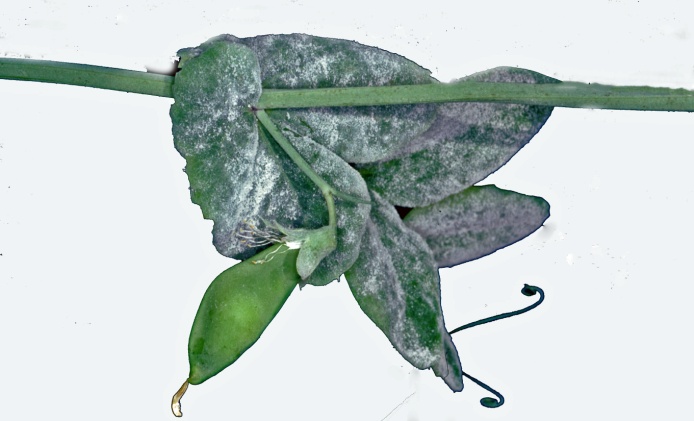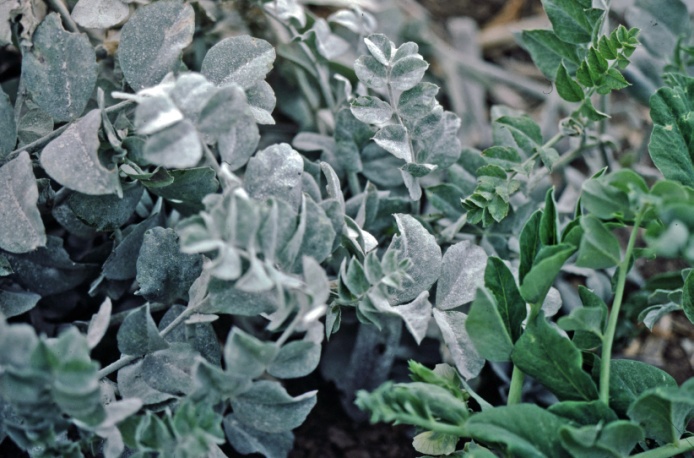Powdery mildew of field peas
Powdery mildew can be a serious disease of field peas grown in Victoria. It occurs sporadically when warm humid conditions favour its growth late in the season. Seed from infected pods can be discoloured and less palatable, which reduces its market value.
What to look for
Infected plants are covered with a white powdery film, and severely infected foliage is blue-white in colour, and the tissue below these infected areas may turn purple. All aerial parts of the plant may become infected resulting in withering of the whole plant.
Severe pod infection can cause a grey-brown discolouration of the seeds. These seeds have an objectionable flavour that lowers the quality of the grain.



Disease cycle
The disease powdery mildew, caused by the pathogen Erysiphe pisi, oversummers on infected pea trash and produces spores which are blown by wind into new crops. The disease may also be seed-borne, but this source of infection is less important.
Under favourable conditions, the disease may completely colonise a plant in 5 to 6 days. Once a few plants become infected, the disease rapidly spreads to adjacent areas. Warm (15-25°C), humid (over 70 per cent RH) conditions for 4 to 5 days late in the growing season, during flowering and pod filling, favour disease development.
However, heavy rainfall is not favourable for the disease as it will actually wash spores off plants. Night time dews are sufficient for the disease to develop.
Economic importance
Severe infections can reduce yield by 10–20 per cent. Powdery mildew is most prevalent late in the season.
Crops sown late are more likely to be affected by powdery mildew than early sown crops. Severe pod infection can lead to poor seed quality.
Management
Variety
Growing a resistant variety is the most effective means of controlling powdery mildew.
For further information on disease ratings refer to the Victorian Pulse Disease Guide.
Seed selection
The use of disease-free seed is recommended. The use of clean seed will minimise the possibility of disease provided the land has not been cropped to peas for several years.
Seed treatment
Seed treatments can be beneficial and are recommended for districts where powdery mildew frequently occurs.
For more information on seed treatments, see the Pulse Australia Bulletin Pulse Seed Treatments and Foliar Fungicides.
Paddock selection
- Leave a 4-year break between growing field pea crops in the same paddock.
- Control volunteer field peas, which can harbour disease.
- Avoid sowing field pea crops adjacent to last season's stubble.
- Incorporate or burn infected pea stubble soon after harvest where practicable.
Sowing rate
Follow the recommended sowing rates from your agronomist and remember that sowing rates may vary between varieties.
Time of sowing
Plan to sow at the optimum time for your district.
For the optimal sowing time for your district refer to the Victorian Winter Crop Summary.
Foliar fungicides
Monitor crops from flowering onwards for signs of powdery mildew. If the disease is present, the application of a foliar spray may be warranted.
- Fungicides need to be applied prior to disease development to be most effective.
- Fungicides for powdery mildew have limited systemic activity, and will not protect the new growth following spraying.
- Good plant coverage with the fungicides is essential.
- Depending on disease pressure, foliage is protected for about 14 days.
- Before using any chemicals check that they are currently registered for use.
Refer to the Pulse Australia bulletin Pulse Seed Treatments and Foliar Fungicides for information on foliar fungicides.
Harvest
Plan to harvest as early as possible to minimise disease on seed and pod shattering.
Further Information
- Pulse Australia
- National Variety Trials
- Field Pea Southern Region – GrowNotes
- Victorian Winter Crop Summary
- Victorian Pulse Disease Guide
- Seed Health Testing in Pulse Crops
- Pulse Seed Treatments and Foliar Fungicides
Contact
Dr Joshua Fanning
Pulse Pathologist – Horsham
0419 272 075
Field Crops Pathology
Grains Innovation Park
110 Natimuk Rd
Horsham 3400
03 5450 8301
Or call the Customer Service Centre, 136 186